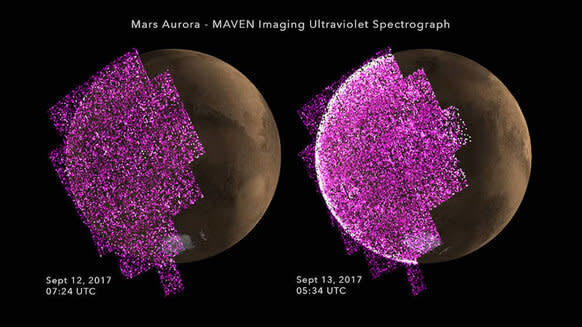What creates the aurora on Mars?
There are three things you need to create an aurora on a planet: 1) A lot of charged subatomic particles moving rapidly, like those continuously blown away from the Sun in its solar wind; 2) a magnetic field, which funnels the particles downward and concentrates them; and 3) an atmosphere filled with fun atoms and molecules that glow brilliantly when struck by a fast moving charged subatomic particle funneled by a magnetic field.
On Earth we have all three of these to spare, and the aurora borealis — or northern lights; or aurora australis for southern lights in our other hemisphere — is a nearly daily occurrence, especially when the Sun is near the peak of its magnetic activity cycle.
But Mars? Mars barely has any air; mostly carbon dioxide but even then the air pressure at the surface is only 0.6% of Earth’s at sea level. Standing on Mars and breathing is like trying to breathe at three times the height of Mount Everest on Earth.
Worse, Mars doesn’t have a global magnetic field. Earth does, created by the convective motion of molten iron in its outer core, with hot material rising, cooling when it reaches the mantle, then sinking back down. Mars also has a molten iron core, but it may not be convecting, so there’s no global magnetic field.
However, when Mars was young its core did convect and the planet did have a magnetic field. All that’s left of it now is a spotty remnant field locked into regions where molten rock erupted when the field was still strong, and the rock hardened and retained an imprint of the field.
Still, surprisingly, it turns out that’s enough. Mars has aurorae.
And now scientists have learned more about them. Using data from NASA’s Mars Atmosphere and Volatile EvolutioN mission, or MAVEN, which has been orbiting the Red Planet since September 22, 2014, they’ve uncovered some of the secrets of discrete aurorae on Mars, which happen in specific regions and tend to be small [link to paper].

In September 2017 MAVEN’s Imaging Ultraviolet Spectrometer detected a diffuse aurora over Mars which occurred during a solar storm. The day before the storm (left) nothing was seen, but during the storm the aurora can be seen along the planet’s edge (right). Photo: NASA/GSFC/Univ. of Colorado
It’s been known that discrete aurorae tend to form near these areas of stronger remnant magnetic fields, which are mostly in the Martian southern hemisphere. MAVEN, however, was able to learn more. It has an instrument on it called the Imaging Ultraviolet Spectrograph, or IUVS, which maps the emission of ultraviolet light coming from Mars.
IUVS has a pretty good view of the areas where the remnant field is strong, and can see them often enough to get decent statistics on how the aurorae generated there depend on the solar wind impinging on them.
What the scientists found is that inside the regions with a relatively strong field, what matters most to get an aurora is the magnetic orientation of the solar wind. This is pretty complicated, but the charged particles in the solar wind create a magnetic field around them, and that field can have a certain shape and orientation. The orientation affects how well the cloud of particles interacts with our own Earthly magnetic field, and the same is true for Mars; they found that only certain orientations of the solar wind’s field will create discrete aurora.
That’s not hugely surprising, since the same thing happens here, but what is surprising is that the strength of the aurora, its brightness, doesn’t seem to depend strongly on what’s called the dynamic pressure of the impinging solar wind. This is like air pressure, but it depends on how densely packed the particles are in the wind and how rapidly they’re moving — just like a stronger wind on Earth will exert more pressure on you and push you harder.
So even if the pressure is strong, the discrete aurorae will depend more on the magnetic field orientation inside these regions of stronger magnetic fields.

NASA’s MAVEN Mars mission is on an elliptical orbit around Mars that is highly tilted so that it very nearly goes over the poles of the planet. At its farthest it just reaches the orbit of Phobos, the innermost of the two moons of Mars. At its lowest it is only 150 km above the planet’s surface, which is inside its tenuous atmosphere. Photo: NASA/CU/LASP
Also weirdly, outside these regions there are still some areas with weaker magnetic fields. These can generate aurorae too, but they depend more on the wind pressure and not the orientation, the opposite of what happens inside the strong regions. Not only that, but more wind pressure doesn’t make the aurorae brighter, it just seems to make more of them. That’s not what happens on Earth; a stronger wind tends to make brighter aurorae.
So why is all this important? For one thing we don’t really understand the extant magnetic field of Mars. It’s weak compared to Earth’s and we can only study it by having spacecraft there. Also, we don’t know much about the ancient Mars magnetic field either, and that’s very important. Our own magnetic field acts as a buffer against the Sun’s wind, which, over eons, can erode away our atmosphere like a sand blaster. We think that’s what happened on Mars billions of years ago, which is why it has a thin atmosphere now. Its air used to be much thicker, and we have copious evidence of liquid water on the surface of Mars back then. When the atmosphere went away so did the water, and Mars went from what may have been a habitable planet to the freezing desert we see today.
Why did this happen? How, in detail?
Every planet in the solar system is a case of “compare and contrast” with our own. By learning about how they work we learn more about our own. And when a planet can lose nearly its entire atmosphere, yeah, that’s something I think we need to have a fairly good grip on understanding.


